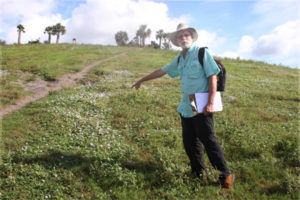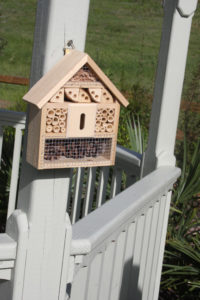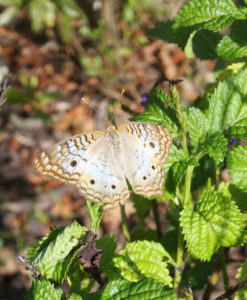
At the Celery Fields Marc Minno stands in the grass behind the Sarasota Audubon Nature Center. He speaks in a casual, low-keyed voice belieing the fact that Minno, a Live Oak resident, is one of Florida’s top butterfly gardening gurus.
A group of people bedecked with binoculars around their necks, cameras dangling off shoulders, notepads sticking out of pockets, sturdy walking shoes and expedition style hats all lean in closer to listen.
“Spanish Needles are one of the top nectar plants for butterflies, also a host plant for Dainty Sulphurs,” says Minno. this is his first visit to the Celery Fields. He came one Saturday in October for a butterfly workshop.
Both Birds and Butterflies Flock to the Celery Fields
Then he reaches down to pick a small piece of ground cover called creeping indigo that attracts the small Ceranus Blue butterfly. Ground cover is good. In fact there are some butterflies and moths that even like Bermuda grass. Who knew?
“Butterflies would love to have some ground cover,” Minno notes. Then he laughs. “Here we are standing outside the beautiful Audubon butterfly garden and we’ve already found butterflies in the ground cover.”
He heads for the butterfly garden path and we all dutifully follow single file. This garden, like the Audubon center, is just two years old. It is full of plants and bushes that attract bees, birds and butterflies.

And recently small beehives were added as a bee habitat incentives. Volunteers maintain the garden.
A White Peacock butterfly sits wings open, waiting for its photo close up while a Cloudless Sulphur flutters by.
Minno tells us there are 170 different kinds of butterflies in Florida along with over 3,000 kinds of moths. The plants that attract butterflies can also attract moths.
He points out so many attractors – beautyberry for the birds, Yopon holly, sienna plants, sunflowers that attracts different kinds of bees and of course are colorful,
The Celery Fields has the Sarasota Audubon Nature Center & a Butterfly Garden
“Your garden is an experiment, “ Minno says. “When you see something that works in another garden and plant it in yours it may or may not work – depends on a mixture of things like sun and shade.”
Bottom line:
“Diversity is good,” says Minno.
Walking around the big Audubon butterfly garden is all very beautiful but can be rather daunting.

So much knowledge needed, so much space needed and yes, time is needed, lots of time for tending.
I ask Minno if he has advice for those who want to get started in butterfly gardening without having grand garden plans or budget.
“You just need four of five plants and you are good to go,” Minno says. He waves his hand towards a nearby garden box planted with fennel and parsley.
“Plant some fennel and parsley,” he says. “Oh, and be sure have some blue passion vine and milkweed. All of this can be in containers.”
After making the garden rounds, the group heads up the steep Celery Fields hill. Over the course of 45 minutes they see 18 different kinds of butterflies.
Butterflies may have another hatching through November then disappear during “winter” in Florida, the cooler months until April. Then they’ll be back.
Want to be ready?
Here are starter suggestions of places to go for inspiration (also see More to Explore):
Celery Fields, Sarasota Audubon Nature Center butterfly garden, 999 Center Road, Sarasota, FL.(free open to the public)
Sarasota County Butterfly Club maintains the Catherine and Richard LaBrie Butterfly Garden outside the Sarasota Garden Club, 1131 Boulevard of the Arts, Sarasota, FL (free, open to the public).
Marie Selby Botanical Gardens, 900 South Palm Avenue, Sarasota FL (admission required) has a butterfly garden and also guided butterfly garden tours – check their calendar of events for dates.
Florida Botanical Gardens, 12520 Umerton Road, Largo, FL. A butterfly garden is one of its display gardens. Admission is free.
Books to read
Florida Butterfly Gardening, Marc C. Minno and Maria Minno, University Press of Florida, 1999
Florida Butterfly Caterpillars and their Host Plants, Marc C Minno, Jerry F. Butler, Donald W. Hall, University Press of Florida, 2005
Florida Gardens Gone Wild(er), Lucy Beebe Tobias, Sea Aster Press, 2015.
More to Explore
Flutter with the Butterflies in Fort Myers
Visiting Florida Butterfly Gardens Could be Sinful
Monarch Butterflies Need YOU Now